application
-
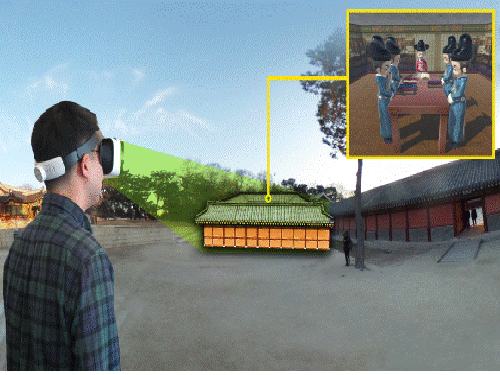 Augmented Reality Application for Smart Tour
‘K-Culture Time Machine,’ an augmented and virtual reality application will create a new way to take a tour. Prof. Woon-taek Woo's research team of Graduate School of Culture Technology of KAIST developed AR/VR application for smart tourism.
The 'K-Culture Time Machine' application (iOS App Store app name: KCTM) was launched on iOS App Store in Korea on May 22 as a pilot service that is targetting the Changdeokgung Palace of Seoul.
The application provides remote experience over time and space for cultural heritage or relics thorough wearable 360-degree video. Users can remotely experience cultural heritage sites with 360-degree video provided by installing a smartphone in a smartphone HMD device, and can search information on historical figures, places, and events related to cultural heritage. Also, 3D reconstruction of lost cultural heritage can be experienced.
Without using wearable HMD devices, mobile-based cultural heritage guides can be provided based on the vision-based recognition on the cultural heritages. Through the embedded camera in smartphone, the application can identify the heritages and provide related information and contents of the hertages. For example, in Changdeokgung Palace, a user can move inside the Changdeokgung Palace from Donhwa-Gate (the main gate of the Changdeokgung Palace), Injeong-Jeon(main hall), Injeong-Moon (Main gate of Injeong-Jeon), and to Huijeongdang (rest place for the king). Through the 360 degree panoramic image or video, the user can experience the virtual scene of heritages.
The virtual 3D reconstruction of the seungjeongwon (Royal Secretariat) which does not exist at present can be shown of the east side of the Injeong-Jeon The functions can be experienced on a smartphone without a wearable device, and it would be a commercial application that can be utilized in the field once the augmented reality function which is under development is completed.
Professor Woo and his research team constructed and applied standardized metadata of cultural heritage database and AR/VR contents. Through this standardized metadata, unlike existing applications which are temporarily consumed after development, reusable and interoperable contents can be made.Professor Woo said, "By enhancing the interoperability and reusability of AR contents, we will be able to preoccupy new markets in the field of smart tourism."
The research was conducted through the joint work with Post Media (CEO Hong Seung-mo) in the CT R&D project of the Ministry of Culture, Sports and Tourism of Korea. The results of the research will be announced through the HCI International 2017 conference in Canada this July.
Figure 1. 360 degree panorama image / video function screen of 'K-Culture Time Machine'. Smartphone HMD allows users to freely experience various cultural sites remotely.
Figure 2. 'K-Culture Time Machine' mobile augmented reality function screen. By analyzing the location of the user and the screen viewed through the camera, information related to the cultural heritage are provided to enhance the user experience.
Figure 3. The concept of 360-degree panoramic video-based VR service of "K-Culture Time Machine", a wearable application supporting smart tour of the historical sites. Through the smartphone HMD, a user can remotely experience cultural heritage sites and 3D reconstruction of cultural heritage that does not currently exist.
2017.05.30 View 12100
Augmented Reality Application for Smart Tour
‘K-Culture Time Machine,’ an augmented and virtual reality application will create a new way to take a tour. Prof. Woon-taek Woo's research team of Graduate School of Culture Technology of KAIST developed AR/VR application for smart tourism.
The 'K-Culture Time Machine' application (iOS App Store app name: KCTM) was launched on iOS App Store in Korea on May 22 as a pilot service that is targetting the Changdeokgung Palace of Seoul.
The application provides remote experience over time and space for cultural heritage or relics thorough wearable 360-degree video. Users can remotely experience cultural heritage sites with 360-degree video provided by installing a smartphone in a smartphone HMD device, and can search information on historical figures, places, and events related to cultural heritage. Also, 3D reconstruction of lost cultural heritage can be experienced.
Without using wearable HMD devices, mobile-based cultural heritage guides can be provided based on the vision-based recognition on the cultural heritages. Through the embedded camera in smartphone, the application can identify the heritages and provide related information and contents of the hertages. For example, in Changdeokgung Palace, a user can move inside the Changdeokgung Palace from Donhwa-Gate (the main gate of the Changdeokgung Palace), Injeong-Jeon(main hall), Injeong-Moon (Main gate of Injeong-Jeon), and to Huijeongdang (rest place for the king). Through the 360 degree panoramic image or video, the user can experience the virtual scene of heritages.
The virtual 3D reconstruction of the seungjeongwon (Royal Secretariat) which does not exist at present can be shown of the east side of the Injeong-Jeon The functions can be experienced on a smartphone without a wearable device, and it would be a commercial application that can be utilized in the field once the augmented reality function which is under development is completed.
Professor Woo and his research team constructed and applied standardized metadata of cultural heritage database and AR/VR contents. Through this standardized metadata, unlike existing applications which are temporarily consumed after development, reusable and interoperable contents can be made.Professor Woo said, "By enhancing the interoperability and reusability of AR contents, we will be able to preoccupy new markets in the field of smart tourism."
The research was conducted through the joint work with Post Media (CEO Hong Seung-mo) in the CT R&D project of the Ministry of Culture, Sports and Tourism of Korea. The results of the research will be announced through the HCI International 2017 conference in Canada this July.
Figure 1. 360 degree panorama image / video function screen of 'K-Culture Time Machine'. Smartphone HMD allows users to freely experience various cultural sites remotely.
Figure 2. 'K-Culture Time Machine' mobile augmented reality function screen. By analyzing the location of the user and the screen viewed through the camera, information related to the cultural heritage are provided to enhance the user experience.
Figure 3. The concept of 360-degree panoramic video-based VR service of "K-Culture Time Machine", a wearable application supporting smart tour of the historical sites. Through the smartphone HMD, a user can remotely experience cultural heritage sites and 3D reconstruction of cultural heritage that does not currently exist.
2017.05.30 View 12100 -
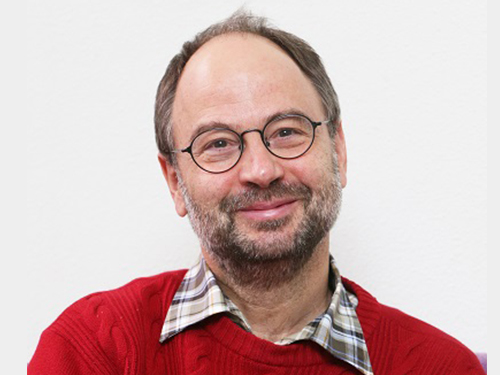 Professor Otfried Cheong Named as Distinguished Scientist by ACM
Professor Otfried Cheong (Schwarzkopf) of the School of Computing was named as a Distinguished Scientist of 2016 by the Association for Computing Machinery (ACM).
The ACM recognized 45 Distinguished Members in the category of Distinguished Scientist, Educator, and Engineer for their individual contributions to the field of computing. Professor Cheong is the sole recipient from a Korean institution. The recipients were selected among the top 10 percent of ACM members with at least 15 years of professional experience and five years of continuous professional membership.
He is known as one of the authors of the widely used computational geometry textbook Computational Geometry: Algorithms and Applications and as the developer of Ipe, a vector graphics editor. Professor Cheong joined KAIST in 2005, after earning his doctorate from the Free University of Berlin in 1992. He previously taught at Ultrecht University, Pohang University of Science and Technology, Hong Kong University of Science and Technology, and the Eindhoven University of Technology.
2017.04.17 View 8503
Professor Otfried Cheong Named as Distinguished Scientist by ACM
Professor Otfried Cheong (Schwarzkopf) of the School of Computing was named as a Distinguished Scientist of 2016 by the Association for Computing Machinery (ACM).
The ACM recognized 45 Distinguished Members in the category of Distinguished Scientist, Educator, and Engineer for their individual contributions to the field of computing. Professor Cheong is the sole recipient from a Korean institution. The recipients were selected among the top 10 percent of ACM members with at least 15 years of professional experience and five years of continuous professional membership.
He is known as one of the authors of the widely used computational geometry textbook Computational Geometry: Algorithms and Applications and as the developer of Ipe, a vector graphics editor. Professor Cheong joined KAIST in 2005, after earning his doctorate from the Free University of Berlin in 1992. He previously taught at Ultrecht University, Pohang University of Science and Technology, Hong Kong University of Science and Technology, and the Eindhoven University of Technology.
2017.04.17 View 8503 -
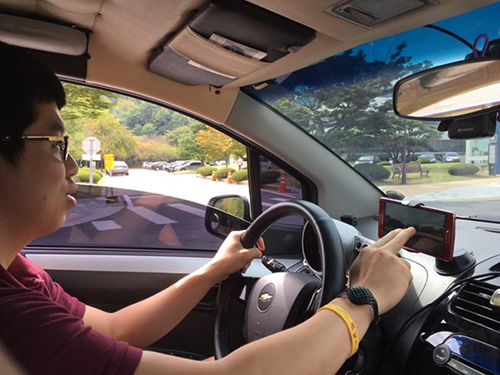 Improving Traffic Safety with a Crowdsourced Traffic Violation Reporting App
KAIST researchers revealed that crowdsourced traffic violation reporting with smartphone-based continuous video capturing can dramatically change the current practice of policing activities on the road and will significantly improve traffic safety.
Professor Uichin Lee of the Department of Industrial and Systems Engineering and the Graduate School of Knowledge Service Engineering at KAIST and his research team designed and evaluated Mobile Roadwatch, a mobile app that helps citizen record traffic violation with their smartphones and report the recorded videos to the police.
This app supports continuous video recording just like onboard vehicle dashboard cameras. Mobile Roadwatch allows drivers to safely capture traffic violations by simply touching a smartphone screen while driving. The captured videos are automatically tagged with contextual information such as location and time. This information will be used as important evidence for the police to ticket the violators. All of the captured videos can be conveniently reviewed, allowing users to decide which events to report to the police.
The team conducted a two-week field study to understand how drivers use Mobile Roadwatch. They found that the drivers tended to capture all traffic risks regardless of the level of their involvement and the seriousness of the traffic risks. However, when it came to actual reporting, they tended to report only serious traffic violations, which could have led to car accidents, such as traffic signal violations and illegal U-turns. After receiving feedback about their reports from the police, drivers typically felt very good about their contributions to traffic safety.
At the same time, some drivers felt pleased to know that the offenders received tickets since they thought these offenders deserved to be ticketed. While participating in the Mobile Roadwatch campaign, drivers reported that they tried to drive as safely as possible and abide by traffic laws. This was because they wanted to be as fair as possible so that they could capture others’ violations without feeling guilty. They were also afraid that other drivers might capture their violations.
Professor Lee said, “Our study participants answered that Mobile Roadwatch served as a very useful tool for reporting traffic violations, and they were highly satisfied with its features. Beyond simple reporting, our tool can be extended to support online communities, which help people actively discuss various local safety issues and work with the police and local authorities to solve these safety issues.”
Korea and India were the early adaptors supporting video-based reporting of traffic violations to the police. In recent years, the number of reports has dramatically increased. For example, Korea’s ‘Looking for a Witness’ (released in April 2015) received more than half million reported violations as of November 2016. In the US, authorities started tapping into smartphone recordings by releasing video-based reporting apps such as ICE Blackbox and Mobile Justice. Professor Lee said that the existing services cannot be used while driving, because none of the existing services support continuous video recording and safe event capturing behind the wheel.
Professor Lee’s team has been incorporating advanced computer vision techniques into Mobile Roadwatch for automatically capturing traffic violations and safety risks, including potholes and obstacles. The researchers will present their results in May at the ACM CHI Conference on Human Factors in Computing Systems (CHI 2017) in Denver, CO, USA. Their research was supported by the KAIST-KUSTAR fund.
(Caption: A driver is trying to capture an event by touching a screen. The Mobile Radwatch supports continuous video recording and safe event captureing behind the wheel.)
2017.04.10 View 11186
Improving Traffic Safety with a Crowdsourced Traffic Violation Reporting App
KAIST researchers revealed that crowdsourced traffic violation reporting with smartphone-based continuous video capturing can dramatically change the current practice of policing activities on the road and will significantly improve traffic safety.
Professor Uichin Lee of the Department of Industrial and Systems Engineering and the Graduate School of Knowledge Service Engineering at KAIST and his research team designed and evaluated Mobile Roadwatch, a mobile app that helps citizen record traffic violation with their smartphones and report the recorded videos to the police.
This app supports continuous video recording just like onboard vehicle dashboard cameras. Mobile Roadwatch allows drivers to safely capture traffic violations by simply touching a smartphone screen while driving. The captured videos are automatically tagged with contextual information such as location and time. This information will be used as important evidence for the police to ticket the violators. All of the captured videos can be conveniently reviewed, allowing users to decide which events to report to the police.
The team conducted a two-week field study to understand how drivers use Mobile Roadwatch. They found that the drivers tended to capture all traffic risks regardless of the level of their involvement and the seriousness of the traffic risks. However, when it came to actual reporting, they tended to report only serious traffic violations, which could have led to car accidents, such as traffic signal violations and illegal U-turns. After receiving feedback about their reports from the police, drivers typically felt very good about their contributions to traffic safety.
At the same time, some drivers felt pleased to know that the offenders received tickets since they thought these offenders deserved to be ticketed. While participating in the Mobile Roadwatch campaign, drivers reported that they tried to drive as safely as possible and abide by traffic laws. This was because they wanted to be as fair as possible so that they could capture others’ violations without feeling guilty. They were also afraid that other drivers might capture their violations.
Professor Lee said, “Our study participants answered that Mobile Roadwatch served as a very useful tool for reporting traffic violations, and they were highly satisfied with its features. Beyond simple reporting, our tool can be extended to support online communities, which help people actively discuss various local safety issues and work with the police and local authorities to solve these safety issues.”
Korea and India were the early adaptors supporting video-based reporting of traffic violations to the police. In recent years, the number of reports has dramatically increased. For example, Korea’s ‘Looking for a Witness’ (released in April 2015) received more than half million reported violations as of November 2016. In the US, authorities started tapping into smartphone recordings by releasing video-based reporting apps such as ICE Blackbox and Mobile Justice. Professor Lee said that the existing services cannot be used while driving, because none of the existing services support continuous video recording and safe event capturing behind the wheel.
Professor Lee’s team has been incorporating advanced computer vision techniques into Mobile Roadwatch for automatically capturing traffic violations and safety risks, including potholes and obstacles. The researchers will present their results in May at the ACM CHI Conference on Human Factors in Computing Systems (CHI 2017) in Denver, CO, USA. Their research was supported by the KAIST-KUSTAR fund.
(Caption: A driver is trying to capture an event by touching a screen. The Mobile Radwatch supports continuous video recording and safe event captureing behind the wheel.)
2017.04.10 View 11186 -
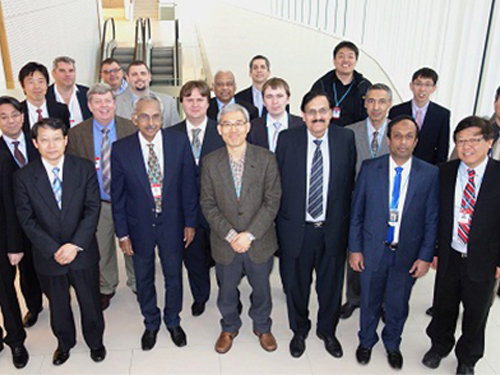 Professor Rim Presents at IAEA Workshop in Vienna
Professor Chun-Taek Rim of the Department of Nuclear and Quantum Engineering at KAIST recently attended the International Atomic Energy Agency (IAEA)’s workshop on the Application of Wireless Technologies in Nuclear Power Plant Instrumentation and Control System. It took place on March 30-April 2, 2015, in Vienna, Austria.
Representing Korea, Professor Rim gave a talk entitled “Highly Reliable Wireless Power and Communications under Severe Accident of Nuclear Power Plants (NPPs).” About 20 industry experts from 12 countries such as AREVA (France), Westinghouse (US), Oak Ridge National Laboratory (US), Hitachi (Japan), and ENEA (Italy) joined the meeting.
The IAEA hosted the workshop to explore the application of wireless technology for the operation and management of NPPs. It formed a committee consisting of eminent professionals worldwide in NPP instrumentation and control systems, communications, and nuclear power to examine this issue in-depth and to conduct various research projects for the next three years.
In particular, the committee will concentrate its research on improving the reliability and safety of using wireless technology, not only in the normal operation of nuclear plants but also in extreme conditions such as the Fukushima Daiichi nuclear accident. The complementation, economic feasibility, and standardization of NPPs when applying wireless technology will be also discussed.
Professor Rim currently leads the Nuclear Power Electronics
and Robotics Lab at KAIST (http://tesla.kaist.ac.kr/index_eng.php?lag=eng).
Picture 1: Professors Rim presents his topic at the IAEA Workshop in Vienna.
Picture 2: The IAEA Workshop Participants
2015.04.07 View 13510
Professor Rim Presents at IAEA Workshop in Vienna
Professor Chun-Taek Rim of the Department of Nuclear and Quantum Engineering at KAIST recently attended the International Atomic Energy Agency (IAEA)’s workshop on the Application of Wireless Technologies in Nuclear Power Plant Instrumentation and Control System. It took place on March 30-April 2, 2015, in Vienna, Austria.
Representing Korea, Professor Rim gave a talk entitled “Highly Reliable Wireless Power and Communications under Severe Accident of Nuclear Power Plants (NPPs).” About 20 industry experts from 12 countries such as AREVA (France), Westinghouse (US), Oak Ridge National Laboratory (US), Hitachi (Japan), and ENEA (Italy) joined the meeting.
The IAEA hosted the workshop to explore the application of wireless technology for the operation and management of NPPs. It formed a committee consisting of eminent professionals worldwide in NPP instrumentation and control systems, communications, and nuclear power to examine this issue in-depth and to conduct various research projects for the next three years.
In particular, the committee will concentrate its research on improving the reliability and safety of using wireless technology, not only in the normal operation of nuclear plants but also in extreme conditions such as the Fukushima Daiichi nuclear accident. The complementation, economic feasibility, and standardization of NPPs when applying wireless technology will be also discussed.
Professor Rim currently leads the Nuclear Power Electronics
and Robotics Lab at KAIST (http://tesla.kaist.ac.kr/index_eng.php?lag=eng).
Picture 1: Professors Rim presents his topic at the IAEA Workshop in Vienna.
Picture 2: The IAEA Workshop Participants
2015.04.07 View 13510 -
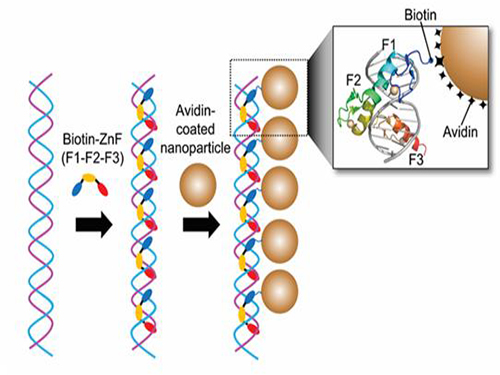 Nanoparticle Cluster Manufacturing Technique Using DNA Binding Protein Developed
Professor Hak-Sung Kim of the Department of Biological Sciences at KAIST and Yiseul Ryu, a doctoral candidate, used the Zinc Finger protein that specifically binds to target DNA sequence to develop a new manufacturing technique for size-controllable magnetic Nanoparticle Clusters (NPCs). Their research results were published in Angewandte Chemie International Edition online on 25 November 2014.
NPCs are structures consisting of magnetic nanoparticles, gold nanoparticles, and quantum dots, each of which are smaller than 100 nm (10-9m). NPCs have a distinctive property of collectivity not seen in single nanoparticles.
Specifically NPCS differ in physical and optical properties such as Plasmon coupling absorbance, energy transfers between particles, electron transfers, and conductivity. Therefore, NPCs can be employed in biological and medical research as well as the development of nanoelectric and nanoplasmon devices.
To make use of these novel properties, the size and the composition of the cluster must be exquisitely controlled. However, previous techniques relied on chemical binding which required complex steps, making it difficult to control the size and composition of NPCs.
Professor Kim’s team used Zinc Finger, a DNA binding protein, to develop a NPCs manufacturing technique to create clusters of the desired size easily. The Zinc Finger protein contains a zinc ion and specifically recognizes DNA sequence upon binding, which allows the exquisite control of the size and the cluster composition. The technique is also bio-friendly.
Professor Kim’s team created linear structure of different sizes of NPCs using Zinc Finger proteins and three DNA sequences of different lengths. The NPCs they produced confirmed their ability to control the size and structure of the cluster by using different DNA lengths.
The NPCs showed tripled T2 relaxation rates compared to the existing MRI contrast media (Feridex) and effectively transported to targeted cells. The research findings show the potential use of NPCs in biological and medical fields such as MRI contrast media, fluorescence imaging, and drug transport.
The research used the specific binding property of protein and DNA to develop a new method to create an inorganic nanoparticle’s supramolecular assembly. The technique can be used and applied extensively in other nanoparticles for future research in diagnosis, imaging, and drug and gene delivery.
Figure 1. A Mimetic Diagram of NPCs Manufacturing Technique Using DNA Binding Protein Zinc Finger
Figure 2. Transmission Electron Microscopy Images showing different sizes of NPCs depending on the length of the DNA
2014.12.04 View 13791
Nanoparticle Cluster Manufacturing Technique Using DNA Binding Protein Developed
Professor Hak-Sung Kim of the Department of Biological Sciences at KAIST and Yiseul Ryu, a doctoral candidate, used the Zinc Finger protein that specifically binds to target DNA sequence to develop a new manufacturing technique for size-controllable magnetic Nanoparticle Clusters (NPCs). Their research results were published in Angewandte Chemie International Edition online on 25 November 2014.
NPCs are structures consisting of magnetic nanoparticles, gold nanoparticles, and quantum dots, each of which are smaller than 100 nm (10-9m). NPCs have a distinctive property of collectivity not seen in single nanoparticles.
Specifically NPCS differ in physical and optical properties such as Plasmon coupling absorbance, energy transfers between particles, electron transfers, and conductivity. Therefore, NPCs can be employed in biological and medical research as well as the development of nanoelectric and nanoplasmon devices.
To make use of these novel properties, the size and the composition of the cluster must be exquisitely controlled. However, previous techniques relied on chemical binding which required complex steps, making it difficult to control the size and composition of NPCs.
Professor Kim’s team used Zinc Finger, a DNA binding protein, to develop a NPCs manufacturing technique to create clusters of the desired size easily. The Zinc Finger protein contains a zinc ion and specifically recognizes DNA sequence upon binding, which allows the exquisite control of the size and the cluster composition. The technique is also bio-friendly.
Professor Kim’s team created linear structure of different sizes of NPCs using Zinc Finger proteins and three DNA sequences of different lengths. The NPCs they produced confirmed their ability to control the size and structure of the cluster by using different DNA lengths.
The NPCs showed tripled T2 relaxation rates compared to the existing MRI contrast media (Feridex) and effectively transported to targeted cells. The research findings show the potential use of NPCs in biological and medical fields such as MRI contrast media, fluorescence imaging, and drug transport.
The research used the specific binding property of protein and DNA to develop a new method to create an inorganic nanoparticle’s supramolecular assembly. The technique can be used and applied extensively in other nanoparticles for future research in diagnosis, imaging, and drug and gene delivery.
Figure 1. A Mimetic Diagram of NPCs Manufacturing Technique Using DNA Binding Protein Zinc Finger
Figure 2. Transmission Electron Microscopy Images showing different sizes of NPCs depending on the length of the DNA
2014.12.04 View 13791 -
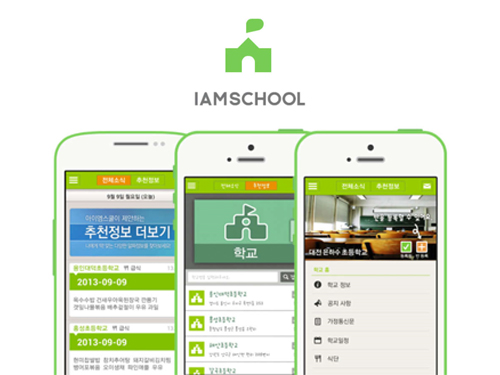 IAMCOMPANY, an educational technology startup created by a KAIST student, featured online in EdSurge
EdSurge is a U.S.-based online news site focused on education and technology innovation, which published an article, dated August 12, 2014, on IAMCOMPANY (http://iamcompany.net), a startup created by a KAIST student, Inmo (Ryan) Chung.
The article introduced one of the company’s most popular and free smartphone applications called “IAMSCHOOL” that “funnels school announcements and class notices to parents’ smartphones using a format similar to Twitter and Google+.”
For more about IAMCOMPANY, please visit the link below:
EdSurge, August 12, 2014
“South Korea’s Biggest Educational Information App Plans Pan-Asian Expansion”
https://www.edsurge.com/n/2014-08-12-south-korea-s-biggest-educational-information-app-plans-pan-asian-expansion
2014.08.19 View 8622
IAMCOMPANY, an educational technology startup created by a KAIST student, featured online in EdSurge
EdSurge is a U.S.-based online news site focused on education and technology innovation, which published an article, dated August 12, 2014, on IAMCOMPANY (http://iamcompany.net), a startup created by a KAIST student, Inmo (Ryan) Chung.
The article introduced one of the company’s most popular and free smartphone applications called “IAMSCHOOL” that “funnels school announcements and class notices to parents’ smartphones using a format similar to Twitter and Google+.”
For more about IAMCOMPANY, please visit the link below:
EdSurge, August 12, 2014
“South Korea’s Biggest Educational Information App Plans Pan-Asian Expansion”
https://www.edsurge.com/n/2014-08-12-south-korea-s-biggest-educational-information-app-plans-pan-asian-expansion
2014.08.19 View 8622 -
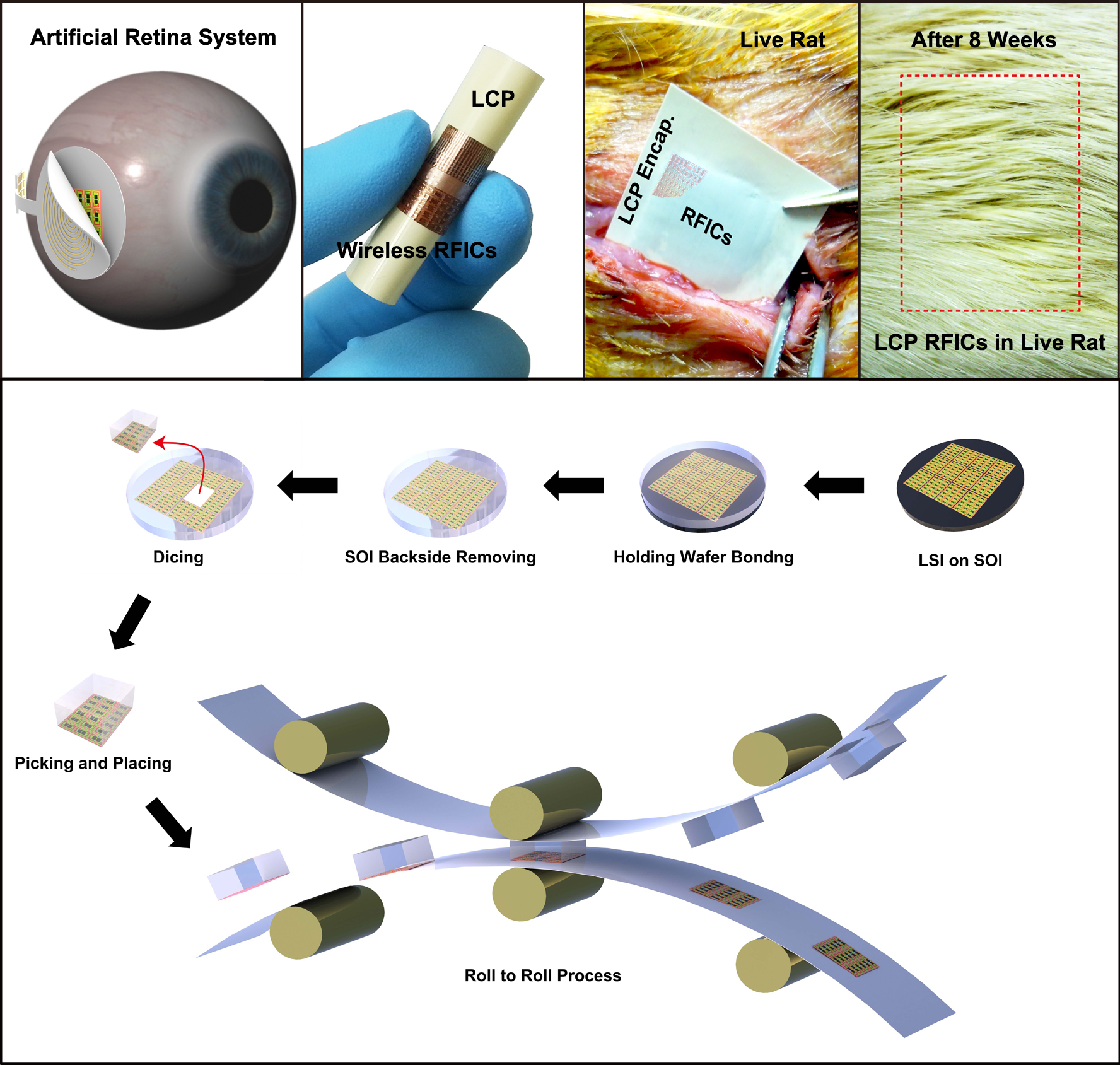 A KAIST research team developed in vivo flexible large scale integrated circuits
Daejeon, Republic of Korea, May 6th, 2013–-A team led by Professor Keon Jae Lee from the Department of Materials Science and Engineering at KAIST has developed in vivo silicon-based flexible large scale integrated circuits (LSI) for bio-medical wireless communication.
Silicon-based semiconductors have played significant roles in signal processing, nerve stimulation, memory storage, and wireless communication in implantable electronics. However, the rigid and bulky LSI chips have limited uses in in vivo devices due to incongruent contact with the curvilinear surfaces of human organs. Especially, artificial retinas recently approved by the Food and Drug Administration (refer to the press release of FDA"s artificial retina approval) require extremely flexible and slim LSI to incorporate it within the cramped area of the human eye.
Although several research teams have fabricated flexible integrated circuits (ICs, tens of interconnected transistors) on plastics, their inaccurate nano-scale alignment on plastics has restricted the demonstration of flexible nano-transistors and their large scale interconnection for in vivo LSI applications such as main process unit (MPU), high density memory and wireless communication. Professor Lee"s team previously demonstrated fully functional flexible memory using ultrathin silicon membranes (Nano Letters, Flexible Memristive Memory Array on Plastic Substrates), however, its integration level and transistor size (over micron scale) have limited functional applications for flexible consumer electronics.
Professor Keon Jae Lee"s team fabricated radio frequency integrated circuits (RFICs) interconnected with thousand nano-transistors on silicon wafer by state-of-the-art CMOS process, and then they removed the entire bottom substrate except top 100 nm active circuit layer by wet chemical etching. The flexible RF switches for wireless communication were monolithically encapsulated with biocompatible liquid crystal polymers (LCPs) for in vivo bio-medical applications. Finally, they implanted the LCP encapsulated RFICs into live rats to demonstrate the stable operation of flexible devices under in vivo circumstances.
Professor Lee said, "This work could provide an approach to flexible LSI for an ideal artificial retina system and other bio-medical devices. Moreover, the result represents an exciting technology with the strong potential to realize fully flexible consumer electronics such as application processor (AP) for mobile operating system, high-capacity memory, and wireless communication in the near future."
This result was published in the May online issue of the American Chemical Society"s journal, ACS Nano (In vivo Flexible RFICs Monolithically Encapsulated with LCP). They are currently engaged in commercializing efforts of roll-to-roll printing of flexible LSI on large area plastic substrates.
Movie at Youtube Link: Fabrication process for flexible LSI for flexible display, wearable computer and artificial retina for in vivo biomedical application
http://www.youtube.com/watch?v=5PpbM7m2PPs&feature=youtu.be
Applications of in Vivo Flexible Large Scale Integrated Circuits
Top: In vivo flexible large scale integrated circuits (LSI); Bottom: Schematic of roll-to-roll printing of flexible LSI on large area plastics.
2013.06.09 View 14532
A KAIST research team developed in vivo flexible large scale integrated circuits
Daejeon, Republic of Korea, May 6th, 2013–-A team led by Professor Keon Jae Lee from the Department of Materials Science and Engineering at KAIST has developed in vivo silicon-based flexible large scale integrated circuits (LSI) for bio-medical wireless communication.
Silicon-based semiconductors have played significant roles in signal processing, nerve stimulation, memory storage, and wireless communication in implantable electronics. However, the rigid and bulky LSI chips have limited uses in in vivo devices due to incongruent contact with the curvilinear surfaces of human organs. Especially, artificial retinas recently approved by the Food and Drug Administration (refer to the press release of FDA"s artificial retina approval) require extremely flexible and slim LSI to incorporate it within the cramped area of the human eye.
Although several research teams have fabricated flexible integrated circuits (ICs, tens of interconnected transistors) on plastics, their inaccurate nano-scale alignment on plastics has restricted the demonstration of flexible nano-transistors and their large scale interconnection for in vivo LSI applications such as main process unit (MPU), high density memory and wireless communication. Professor Lee"s team previously demonstrated fully functional flexible memory using ultrathin silicon membranes (Nano Letters, Flexible Memristive Memory Array on Plastic Substrates), however, its integration level and transistor size (over micron scale) have limited functional applications for flexible consumer electronics.
Professor Keon Jae Lee"s team fabricated radio frequency integrated circuits (RFICs) interconnected with thousand nano-transistors on silicon wafer by state-of-the-art CMOS process, and then they removed the entire bottom substrate except top 100 nm active circuit layer by wet chemical etching. The flexible RF switches for wireless communication were monolithically encapsulated with biocompatible liquid crystal polymers (LCPs) for in vivo bio-medical applications. Finally, they implanted the LCP encapsulated RFICs into live rats to demonstrate the stable operation of flexible devices under in vivo circumstances.
Professor Lee said, "This work could provide an approach to flexible LSI for an ideal artificial retina system and other bio-medical devices. Moreover, the result represents an exciting technology with the strong potential to realize fully flexible consumer electronics such as application processor (AP) for mobile operating system, high-capacity memory, and wireless communication in the near future."
This result was published in the May online issue of the American Chemical Society"s journal, ACS Nano (In vivo Flexible RFICs Monolithically Encapsulated with LCP). They are currently engaged in commercializing efforts of roll-to-roll printing of flexible LSI on large area plastic substrates.
Movie at Youtube Link: Fabrication process for flexible LSI for flexible display, wearable computer and artificial retina for in vivo biomedical application
http://www.youtube.com/watch?v=5PpbM7m2PPs&feature=youtu.be
Applications of in Vivo Flexible Large Scale Integrated Circuits
Top: In vivo flexible large scale integrated circuits (LSI); Bottom: Schematic of roll-to-roll printing of flexible LSI on large area plastics.
2013.06.09 View 14532 -
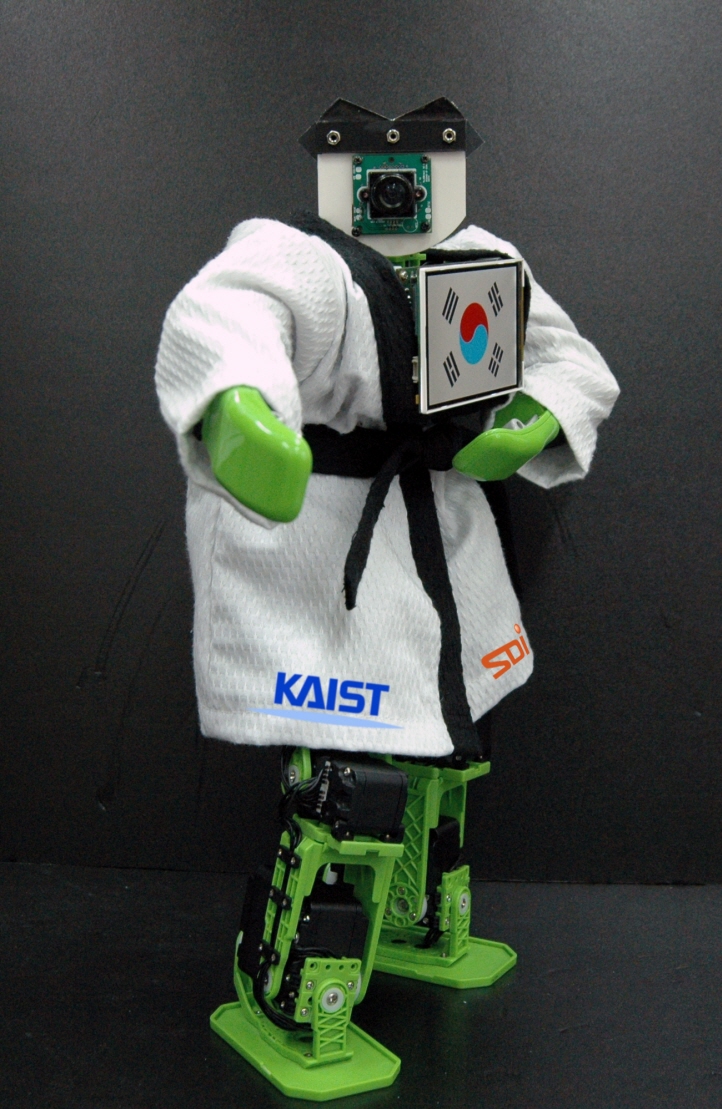 KAIST Holds Robot Taekwondo Competition Recognized by the World Taekwondo Federation
KAIST will host the 12th Intelligent System-on-Chip (SoC) Robot War in October 2013, a robot competition. The event will have two entries: robot Taekwondo contest and HURO competition.
The World Taekwondo Federation has decided to offer an honorary Taekwondo degree to the winner of SoC Taekwondo Robot competition.
The Intelligent SoC Robot War was created in 2002 by KAIST’s Professor Hoi-Jun Yoo in the Department of Electrical Engineering.
For SoC Taekwondo Robot event, two robots compete in the form of Taekwondo, traditional Korean martial arts. The robots competing in this event have a camera and semiconductor chips on board, and therefore they have the brain-like functions to identify an object and control movements on their own. The robots have 21 joints with humanoid robot technology on their body for the techniques needed to compete in a typical Taekwondo match. They employ moves such as front kicks, side kicks, and upper punches.
In particular, KAIST’s System Design Innovation & Application Research Center, the organizer of this competition, has operated a team to demonstrate robot Taekwondo since last year with the purpose of displaying the basic movements of Taekwondo.
“Robots received attention as the source of growth in the near future. We have been developing robotics technology, and as part of our endeavor, preparing the Taekwondo demonstration team since 2012 to exhibit Korea’s robot technology and introduce our traditional martial arts,” said Professor Hoi-Jun Yoo. “We will continue to develop various capabilities for Taekwondo robots in cooperation with the World Taekwondo Federation.”
In HURO-Competition, robots compete for crossing the finishing line first by completing various missions, such as putting in a golf ball or overcoming obstacles while avoiding unexpected accidents. The winning team is awarded with a Presidential Award of Korea.
The 12th Intelligent SoC Robot War Competition is open to all graduate or undergraduate students. For details, visit the homepage at http://www.socrobotwar.org/.
2013.05.06 View 11297
KAIST Holds Robot Taekwondo Competition Recognized by the World Taekwondo Federation
KAIST will host the 12th Intelligent System-on-Chip (SoC) Robot War in October 2013, a robot competition. The event will have two entries: robot Taekwondo contest and HURO competition.
The World Taekwondo Federation has decided to offer an honorary Taekwondo degree to the winner of SoC Taekwondo Robot competition.
The Intelligent SoC Robot War was created in 2002 by KAIST’s Professor Hoi-Jun Yoo in the Department of Electrical Engineering.
For SoC Taekwondo Robot event, two robots compete in the form of Taekwondo, traditional Korean martial arts. The robots competing in this event have a camera and semiconductor chips on board, and therefore they have the brain-like functions to identify an object and control movements on their own. The robots have 21 joints with humanoid robot technology on their body for the techniques needed to compete in a typical Taekwondo match. They employ moves such as front kicks, side kicks, and upper punches.
In particular, KAIST’s System Design Innovation & Application Research Center, the organizer of this competition, has operated a team to demonstrate robot Taekwondo since last year with the purpose of displaying the basic movements of Taekwondo.
“Robots received attention as the source of growth in the near future. We have been developing robotics technology, and as part of our endeavor, preparing the Taekwondo demonstration team since 2012 to exhibit Korea’s robot technology and introduce our traditional martial arts,” said Professor Hoi-Jun Yoo. “We will continue to develop various capabilities for Taekwondo robots in cooperation with the World Taekwondo Federation.”
In HURO-Competition, robots compete for crossing the finishing line first by completing various missions, such as putting in a golf ball or overcoming obstacles while avoiding unexpected accidents. The winning team is awarded with a Presidential Award of Korea.
The 12th Intelligent SoC Robot War Competition is open to all graduate or undergraduate students. For details, visit the homepage at http://www.socrobotwar.org/.
2013.05.06 View 11297 -
 Professor Song Joon Hwa develops new Location Tracking Application
Professor Song Joon Hwa developed a location tracking application that alerts the teacher when students on field trips stray too far from the group via a smartphone and a headset.
Conventional Location Tracking Applications utilize GPS systems and as a consequence does not function indoors where the satellite signal is nonexistent. However Professor Song’s method is unique in the fact that it utilizes radio waves which allows signal transfer both indoors and outdoors.
In addition different alerts are given off in difference locations and therefore the technology can be applied in finding the effectiveness of the field trip and the social behaviors of students.
2012.09.11 View 8719
Professor Song Joon Hwa develops new Location Tracking Application
Professor Song Joon Hwa developed a location tracking application that alerts the teacher when students on field trips stray too far from the group via a smartphone and a headset.
Conventional Location Tracking Applications utilize GPS systems and as a consequence does not function indoors where the satellite signal is nonexistent. However Professor Song’s method is unique in the fact that it utilizes radio waves which allows signal transfer both indoors and outdoors.
In addition different alerts are given off in difference locations and therefore the technology can be applied in finding the effectiveness of the field trip and the social behaviors of students.
2012.09.11 View 8719 -
 KAIST placed the 5th in top 50 global universities for international patent applications
New York Times released an article, dated March 19, 2012, on the statistics of international patent applications filed by global universities during 2011, and with 103 applications published, KAIST was listed the fifth among the top 50 universities, right behind four US universities: University of California (277), the Massachusetts Institute of Technology (179), the University of Texas System (127), and Johns Hopkins University (111). A total of seven Korean universities including KAIST made the top 50 list. For the article, please check the link below:
New York Times, March 19, 2012
“U.S. Universities Retain Lead in Patent Applications”
By Christopher F. Schuetze
http://www.nytimes.com/2012/03/19/world/asia/us-universities-retain-lead-in-patent-applications.html
In addition, for the press release by the World Intellectual Property Organization, the UN agency responsible for the Patent Cooperation Treaty, on international patent filings in 2011, please click the following link:
“International Patent Filings Set new Record in 2011”
http://www.wipo.int/pressroom/en/articles/2012/article_0001.html
2012.03.21 View 10484
KAIST placed the 5th in top 50 global universities for international patent applications
New York Times released an article, dated March 19, 2012, on the statistics of international patent applications filed by global universities during 2011, and with 103 applications published, KAIST was listed the fifth among the top 50 universities, right behind four US universities: University of California (277), the Massachusetts Institute of Technology (179), the University of Texas System (127), and Johns Hopkins University (111). A total of seven Korean universities including KAIST made the top 50 list. For the article, please check the link below:
New York Times, March 19, 2012
“U.S. Universities Retain Lead in Patent Applications”
By Christopher F. Schuetze
http://www.nytimes.com/2012/03/19/world/asia/us-universities-retain-lead-in-patent-applications.html
In addition, for the press release by the World Intellectual Property Organization, the UN agency responsible for the Patent Cooperation Treaty, on international patent filings in 2011, please click the following link:
“International Patent Filings Set new Record in 2011”
http://www.wipo.int/pressroom/en/articles/2012/article_0001.html
2012.03.21 View 10484 -
 Professor Choi Han Lim receives Automatica Applications Paper Price
Professor Choi Han Lim of the Department of Aerospace received ‘Automatica Applications Paper Prize’ for the first time ever for a Korean.
Professor Choi published a paper in the Automatica magazine with the topic of ‘Continuous Trajectory Planning of Mobile Sensors for Informative Forecasting’.
Professor Choi dealt with most efficient measuring methods for mobile sensor platforms thereby improving the performance of anticipating environmental changes and proposed key theories for problem solving and also an efficient algorithm.
The research was conducted in cooperation with MIT Department of Aerospace Professor Jonathan How with the support of the National Science Foundation.
Automatica
Journal published by the International Federation of Automatic Control and has been awarding the Automatica Paper Prize every three years.
2011.05.31 View 9150
Professor Choi Han Lim receives Automatica Applications Paper Price
Professor Choi Han Lim of the Department of Aerospace received ‘Automatica Applications Paper Prize’ for the first time ever for a Korean.
Professor Choi published a paper in the Automatica magazine with the topic of ‘Continuous Trajectory Planning of Mobile Sensors for Informative Forecasting’.
Professor Choi dealt with most efficient measuring methods for mobile sensor platforms thereby improving the performance of anticipating environmental changes and proposed key theories for problem solving and also an efficient algorithm.
The research was conducted in cooperation with MIT Department of Aerospace Professor Jonathan How with the support of the National Science Foundation.
Automatica
Journal published by the International Federation of Automatic Control and has been awarding the Automatica Paper Prize every three years.
2011.05.31 View 9150 -
 Professor Hwang Kyu Young Receives Outstanding Contributions Award from DASFAA
Professor Hwang Kyu Young received the 2011 Outstanding Contributions Award from the International Conference on Database Systems for Advanced Applications (DASFAA).
Professor Hwang was the Chairman, Vice Chairman, Executive, etc. of the DASFAA Steering Committee for the past 12 years and has been leading the development in the field of database in the Asia/Pacific Region. He was also the editor in chief of The VLDB Journal which is the leading magazine in the field of database and the member of ACM SIGMOD Jim Gray Dissertation Award Committee, VLDB 10-year Best Paper Award Committee, and IEEE ICDE Influential Paper Awards Committee. He receives the Outstanding Contributions Award for ensuring high standards in world database research.
2011.05.31 View 10211
Professor Hwang Kyu Young Receives Outstanding Contributions Award from DASFAA
Professor Hwang Kyu Young received the 2011 Outstanding Contributions Award from the International Conference on Database Systems for Advanced Applications (DASFAA).
Professor Hwang was the Chairman, Vice Chairman, Executive, etc. of the DASFAA Steering Committee for the past 12 years and has been leading the development in the field of database in the Asia/Pacific Region. He was also the editor in chief of The VLDB Journal which is the leading magazine in the field of database and the member of ACM SIGMOD Jim Gray Dissertation Award Committee, VLDB 10-year Best Paper Award Committee, and IEEE ICDE Influential Paper Awards Committee. He receives the Outstanding Contributions Award for ensuring high standards in world database research.
2011.05.31 View 10211